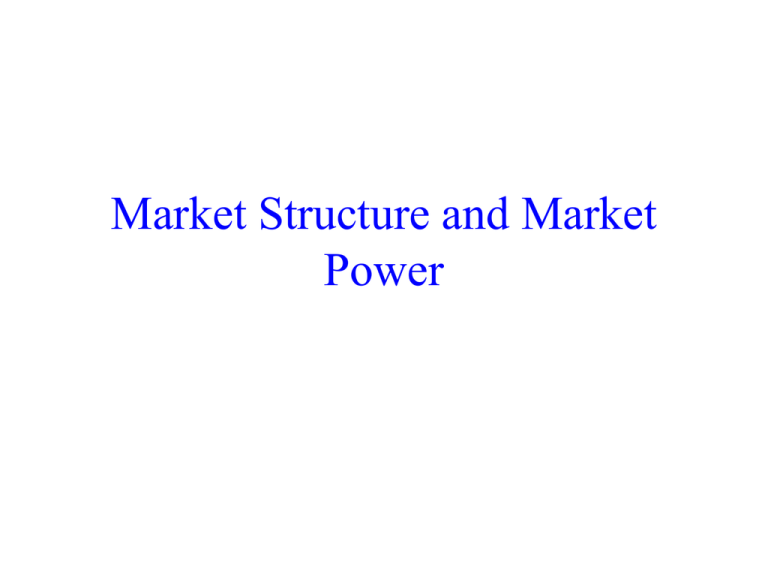Pepall_4e_ch03_revised
advertisement

Market Structure and Market Power Introduction • Industries have very different market structures – By Market Structure, we mean the number of firms in the industry and how these firms vary in size in term so f market share. – A industry is HIGHLY CONCENTRATED if most of the production in the is done by a few, large firms. • ready-to-eat breakfast cereals: high concentration • newspapers: low concentration • StructureConduct Performance (SCP) Paradigm • By Market Conduct, we mean the manner in which firm set the prices of the products in the industry • By Market Performance, we mean the efficiency of the industry and the profitability / market power of firms in the industry. • Firms in an industry have Market Power if they posses the ability to set prices above costs. Introduction • The SCP paradigm believed that the market structure determined market conduct and market conduct determined market performance. • Thus, through an examination of the structure of markets and the organization of firms, the traditional IO economists thought they could explain differences in market outcomes. • By contrast, the New IO begins by investigating how strategic behavior by firms can affect market structure. Chapter 3: Market Structure and Market Power 3 Introduction • Despite these differences, the two approaches do agree that Market Structure - the way that an industry’s producers are organized - affects what happens in the market place. • Moreover, both approaches seek to make causal inferences about the determinant of Market Power. • A natural need arises, then, for descriptive statistics that allow us to characterize Market Structure and Market Power in a meaningful way. Chapter 3: Market Structure and Market Power 4 Introduction • How best to measure market structure • A good measure needs to capture the distribution of firm’s market shares in an industry. – summary measure. – concentration curve, which describes the extent to which output is concentrated in the hands of a just few firms, is possible (See Figure 3.1). – preference is for a single number. – concentration ratio or Herfindahl-Hirschman index. Chapter 3: Market Structure and Market Power 5 CRn and HHI • One way to measure market structure is to focus on the size of the top firms relative to the industry • The concentration ratio of n firms is defined as the sum of market share of top n firms. • HHI is the sum of squares of market shares of all firms in the industry. Chapter 3: Market Structure and Market Power 6 Measure of concentration • Compare two different measures of concentration: Firm Rank Market Market Share (%) Squared Share 1 25 625 2 25 625 3 25 625 4 5 25 5 5 25 6 5 25 7 5 25 8 5 25 Concentration Index CR4 = 80 H = 2,000 Concentration index is affected by, e.g. merger Firm Rank Market Share (%) 1 Assume that firms 2 4 and 5 decide to merge 3 25 4 5 5 6 7 } 25 625 Market shares 625 change 25 625 5 The Concentration Index changes 8 Concentration Index Squared Market Share } 10 25 25 5 25 5 25 5 25 CR4 = 80 85 H = 2,000 } 100 2,050 What is a market? • No clear consensus – the market for automobiles • should we include light trucks; pick-ups SUVs? – the market for soft drinks • what are the competitors for Coca Cola and Pepsi? – With whom do McDonalds and Burger King compete? • Presumably define a market by closeness in substitutability of the commodities involved – how close is close? – how homogeneous do commodities have to be? • Does wood compete with plastic? Rayon with wool? Market definition 2 • Definition is important – without consistency concept of a market is meaningless – need indication of competitiveness of a market: affected by definition – public policy: decisions on mergers can turn on market definition • Staples/Office Depot merger rejected on market definition • Coca Cola expansion turned on market definition • Standard approach has some consistency – based upon industrial data – substitutability in production not consumption (ease of data collection) Market definition 3 • Government statistical sources – FedStats – Naics • The measure of concentration varies across countries • Use of production-based statistics has limitations: – can put in different industries products that are in the same market • The international dimension is important – Boeing/McDonnell-Douglas merger – relevant market for automobiles, oil, hairdressing Market definition 4 • Geography is important – barrier to entry if the product is expensive to transport – but customers can move • what is the relevant market for a beach resort or ski-slope? • Vertical relations between firms are important – – – – most firms make intermediate rather than final goods firm has to make a series of make-or-buy choices upstream and downstream production measures of concentration may assign firms at different stages to the same industry • do vertical relations affect underlying structure? • The existence and variability of vertical relationships can cause difficulty in measuring the structure of the market at any stage of production. Example: the bottled, tin and soft drink industry. Market definition 5 – Firms at different stages may also be assigned to different industries • bottlers of soft drinks: low concentration • suppliers of soft drinks: high concentration • the bottling sector is probably not competitive. • In sum: market definition poses real problems – existing methods represent a reasonable compromise The Role of Policy • Government can directly affect market structure – by limiting entry • taxi medallions in Boston and New York • airline regulation – through the patent system – by protecting competition e.g. through the RobinsonPatman Act Measuring Market Power/Performance • Market structure is often a guide to market performance • But this is not a perfect measure – can have near competitive prices even with “few” firms • Measure market performance using the Lerner Index LI = P-MC P Market Performance 2 • Perfect competition: LI = 0 since P = MC • Monopoly: LI = 1/h – inverse of elasticity of demand • With more than one but not “many” firms, the Lerner Index is more complicated: need to average. – suppose the goods are homogeneous so all firms sell at the same price LI = P-SsiMCi P Lerner Index: Limitations • LI has limitations – measurement: as with “measuring” a market – meaning: measures outcome but not necessarily performance – misspecification: • if there are sunk entry costs that need to be covered by positive price-cost margin • low price by a high-cost incumbent to protect its market Empirical Application: How Bad is Market Power Really? • Harberger (1954) exercise: Welfare Loss (WL) is: 1 WL = 2 (P – MC)(QC – Q) • Welfare Loss in relation to sales: WL = 1 (P – MC) (QC – Q) Q P 2 PQ • This can be expressed as: WL = 1 PQ 2 η (LI)2 How Bad is Market Power Really? 2 • Because most industries are not perfect monopolies, Harberger (1954) calculates WL = 1 η (LI)2 PQ 2 • For 73 manufacturing industries assuming D=1. Multiplying the result by each industry’s output and summing over all industries he estimates a total welfare loss from monopoly power of about one-tenth of one percent of GDP. How Bad is Market Power Really? 3 • Currently, the budget of the Justice Department and the FTC is between one and two-tenths of 1 percent of GDP. While much of this is for activities other than antitrust enforcement, the low value of Harberger’s (1954) estimate still raised a serious question about the cost-effectiveness of antitrust policy. Chapter 3: Market Structure and Market Power 20 How Bad is Market Power Really? 4 • One problem is cost, possibly due to how advertising is 2 treated (P – MC) WL = 1 2 η PQ P • Under imperfect competition, MC may not be minimized, so P – MC may be artificially low. • Corrections by Cowling and Mueller (1978) and Aiginger and Pfaffermayr (1997) raise total cost substantially to between 4 and 13 percent of GDP How Bad is Market Power Really? 4 • 1. 2. Two caveats (at least): An implicit assumption in all these calculations is that it is feasible to have perfect competition in all industries. But costs and technology make this an unlikely outcome. In this sense, the estimates of welfare losses due to monopoly price distortions are too high. The measures are taken from data in which active antitrust enforcement has been the form. In this sense, the measures are an understatement of the potential monopoly-induced welfare losses. Chapter 3: Market Structure and Market Power 22 Fast-Food Outlets McDonald’s Burger King Wendy’s








